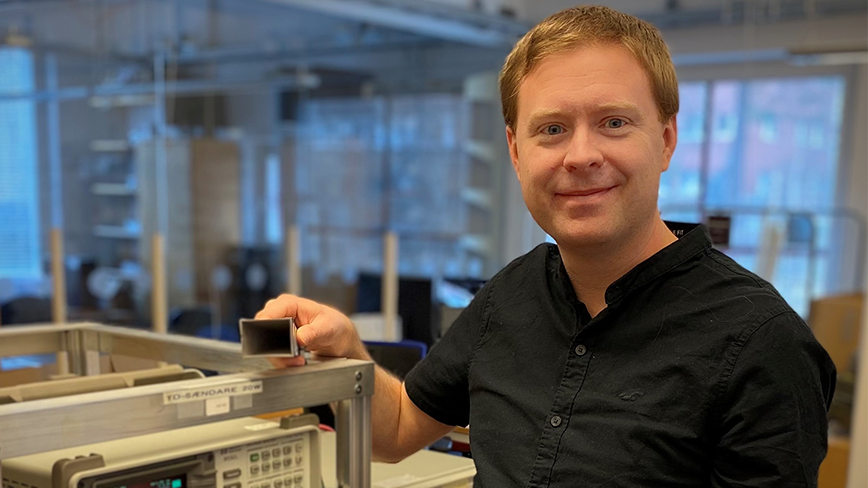Meet Emil Björnson, new professor at EECS

Emil Björnson, newly appointed professor of wireless communication at the Division of communication systems, congratulations on your new position! And congratulations on the IEEE fellow award!
Tell us a little about your background, which road did you take to KTH?
“After studying engineering mathematics in Lund, I decided that I wanted to do a doctorate at KTH. I wanted to work with signal processing methods, but then it was a bit of a coincidence that the signal processing group at KTH applied this method in wireless communication. After I did my doctorate at KTH, I was a faculty member at Linköping University, and now I'm back at KTH as a full professor!”
What are your plans for work at KTH?
“I hope that the IEEE Fellowship will attract even better students and postdocs to KTH. I feel warmly welcomed at KTH through start-up grants from the department and Digital Futures. Together with my Future Research Leader grant from SSF, I can jumpstart my new activities. I plan to build a new strong research base on wireless communications, which KTH has traditionally been strong at. But the first wave of talented researchers in the field is starting to retire now. Wireless technology is something that everyone uses all the time, but that does not mean that it is trivial and finalized technology. We are constantly getting higher demands and expect connectivity to be available. When we talk about digitization of society, we mean that everything should be digitized and accessible wirelessly, everywhere, all the time: those things are not as simple to achieve as you might think.”
You have both a podcast and a Youtube channel about wireless communication, Wireless Future , how come?
“It started with the fact that every time I would give a lecture, I like to spend time creating nice illustrations. So I thought about how to distribute it online and bought a podcast microphone ten years ago, but it did prioritize it. Then I started filming student projects in Linköping and started a Youtube channel in 2016. And so slowly it has filled up with material.”
“Then it gained momentum during the pandemic. I had already practiced recording lectures and had experimented in different ways. But then I started recording all my lectures and research seminars to post them online. Then I thought that now many others who record lectures will see the possibilities of being visible on the Internet, so what can I do to stay one step ahead, and produce better and more interesting material than others? That's how the podcast format came about, my colleague and I noticed that there was no such podcast in our field. We talk about different aspects of wireless technology for an hour, quite often we also invite guests to talk about things outside our expertise.”
Which topic is most popular and who has been the most popular guest?
“Machine learning and its applications in wireless communication are popular. Something else that attracted many listeners was when Magnus Frodigh - head of Ericsson research - was a guest on the podcast and talked about Ericsson's 6G vision.”
What experiences from Youtube have you been able to bring to your teaching and research, and vice versa?
“Yes, there is the opportunity to point to the podcast or the movies, for those who want to learn more. And when it comes to preparing for a podcast recording, you'll have a reason - or be forced - to check out a lot of details. It is a very good way to build up your detailed knowledge in broader subjects and practice talking about advanced concepts in simple ways. I have also created eight repetition videos, which I can refer to for those who need to refresh their memory of the fundamentals.”
If you get to look ahead, what will be the three biggest things in wireless communication in the next five to ten years?
“One important question is ‘what will be the next big device after the mobile phone?’, and there are many expecting it will be something in AR, augmented reality. Google glasses was an attempt that was far too early, but there will probably be a better product in the future. These devices must be wirelessly connected, require fast connectivity but should be energy efficient.”
“When it comes to the infrastructure, we have built different kinds of networks before. We have one for TV, one for FM radio, and we have the post office, but we are gradually moving all communication to the Internet. And everything on the Internet must, according to net neutrality, be handled exactly the same. But all things we use wireless communication for do not have the same requirements. In some cases we should steadily transfer much information, but it doesn’t matter if there are delays, and sometimes it should be very reliable, as when cars tell each other that they are braking, which is not much information. The new thing is that the same mobile network will handle different devices in different ways depending on their needs. There is also a hope of being able to charge customers in new ways, to sell premium services for connected cars, etc.”
“We will also start disconnecting old technology, the 2G and 3G networks, and replace it with new technology. We will suddenly have a fully modern mobile network that will give us new opportunities, even in the rural areas that still lack good connectivity.”
And lastly, what's the most fun part about your job?
“I am passionate about understanding complex theoretical things and then explaining it to others, both in technical books, teaching or podcast format. What drives me is to conduct research and then spread that knowledge further!”
